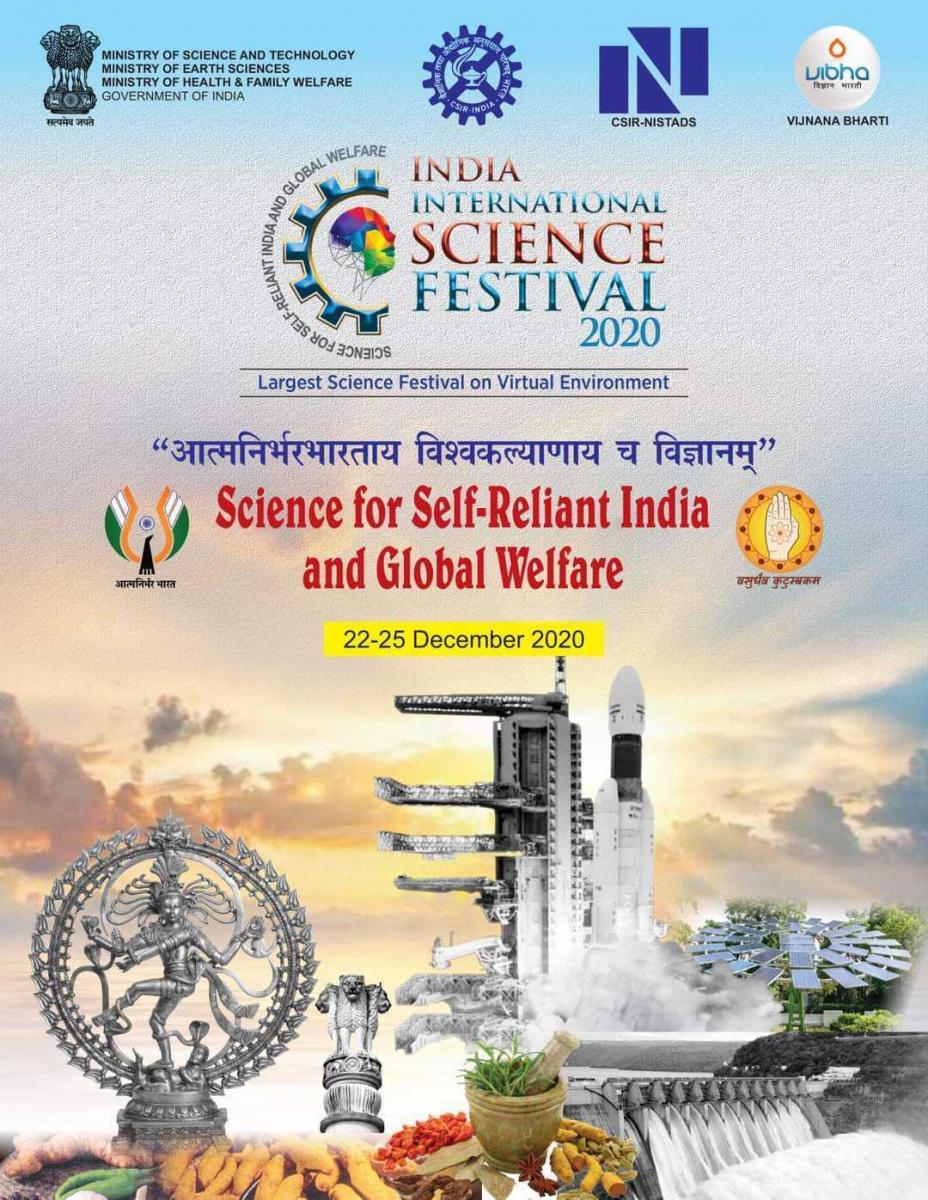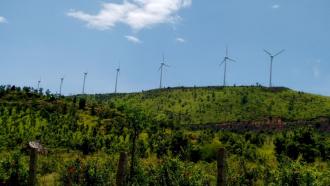The India International Science Festival (IISF) is an annual event organised by the Ministry of Science and Technology, Ministry of Earth Sciences, and the Ministry of Health and Family Welfare, Government of India. Like most other events in the pandemic-stricken-present, in 2020, it was held virtually between the 22nd and 25th of December. While the event faced some well-deserved criticism by Indian scientists and gender activists for furthering systemic gender biases in academia, one issue that has gone unnoticed is the push for saṃskr̥t in the public outreach of the event. (Throughout this piece, the International Alphabet of Sanskrit Transliteration and its derivatives will be used to represent Indian sounds.) Here’s a sampler — a poster talking about the theme of the event.

Apart from English, another language that is on the poster is saṃskr̥t written in the devanāgarī script. Even more recently, the Indian Institute of Technology Kharagpur has released a calendar for 2021 that, in the month of February, claims, “Sanskrit means ‘The most perfected and cultured’ among languages. It is the root of the entire Indo-Aryan branch in Asia and systems of European languages. The ten mandalas of the oldest literature of the world, the Rig Veda, is the basis of 10th or dasam, the unit of decimal system of the world. To name a few only, words (Sabda or Soft) and their embedded ideas (Artha or Worth / Hard) like takkhana (to design and sculpture), jara (old age), asthi (bones), dhatri (child caretaker), kalasa (class taxonomy) are the bases of later knowledge systems namely ‘Technology’, ‘Geriatrics’, ‘Osteopathy’, ‘Paediatrics’ and ‘Ecclesia’, respectively.” While the claims have been busted by more than one expert, it is important to note that irrespective of the falsities, focussing on saṃskr̥t is deeply problematic for science and its communication.
Homogeneity is an illusion, diversity is the reality
India has more than 19,500 different languages, with a significant fraction having no root in saṃskr̥t. These include all languages with tamiḻ links, the languages of the north-east, the tribal and adivāsi languages of central, eastern and north-eastern India, and andamān & nicōbār islands and those in the mountainous north. Although the states in our country were created on the basis of languages, each state further has many other languages spoken by a non-negligible minority. For example, nāgāland is a state where people speak at least 20 languages. Arguably, tamiḻ is among the oldest of the still-spoken languages of the world, comparable in age to saṃskr̥t. Hence, the above poster is dangerously rooted in a view of India that disregards a large fraction of its people, people who are probably more native to the land that we call ‘India’.
Unless, of course, that is its intention.
The insistence of using hiṃdi for most official purposes is proof. Today, most official communication of the Union Government of India is in hiṃdi, written in devanāgarī. However, India does not have a national language, nor is hiṃdi the only official language. There are 22 –– including hiṃdi –– neither of which are any less or more than any other. For example, a Parliamentarian can take the oath of office or give a speech in any of these 22 languages. Besides, each state or UT has a list of official languages for its functioning, like in the Assembly and other matters, e.g., bāŋlā (West Bengal) has 13: bāŋlā (Bengali), English, nēpālī, urdū, hiṃdi, ōṛiā, sāntāli, paṃjābī, kāmtāpurī, rājboŋśiī, kuṛmāli, kuṛukʰ, and tēlugu.
It is important to keep in mind that 'hiṃdi' is an umbrella term for a wide range of languages that include maitʰilī, bʰōjpurī, bajjikā, aŋgikā, and urdū, among others. However, these are not dialects of hiṃdi –– they are languages in their own right. What corresponds to a native version of 'hiṃdi' is spoken probably only in parts of madʰyā pradēś and uttar pradēś. While questioning the hegemony of hiṃdi, we often forget a bigger tragedy: the hiṃdi-cisation of the languages of the region clubbed as the 'hiṃdi belt'. Because of this homogenisation, people within the communities feel ashamed of speaking their mother tongue!
Another aspect notable in the poster is the script: devanāgarī. Let us remind ourselves that saṃskr̥t has been written not only in the devanāgarī script but in many scripts of modern India. Further, it is not correct to assume that saṃskr̥t texts in scripts other than devanāgarī do not exist presently. They do. I have grown up seeing bundle after bundle of the same written in bāŋlā: the saṃskr̥t ślōkā-s recited by priests during pujō (pujā) are all written in bāŋlā. Hence, synonymising saṃskr̥t with devanāgarī only is overlooking reality. Another unfortunate example of enforcing a sadly homogenous view of the world lies in marāṭʰī. Along with kōṃkaṇī, marāṭʰī used to be written in the mōḍī script earlier but has since given way to devanāgarī-cisation.
According to the 2011 Census in India, only 0.19% of people in the country speak saṃskr̥t, as opposed to 10.67% who speak English, 8.85% bāŋlā, 8.18% marāṭʰī, 7.77% tēlugu, 6.36% speak tamiḻ, etc. However, the words used in the poster are ātṃanirbʰar, viŋyan, viśva, kalyān. From my limited experience of travelling in India and talking to locals, people of tribal & adivāsi belts of the country, the people of north-east and also southern India intuitively prefer English over saṃskr̥t or its derivatives like hiṃdi. Hence, a large fraction of Indians would not relate to these words, and this fraction is smaller than those who would understand the English description. On the other hand, English is very much an Indian language –– we speak it with our accents and nuances.
Moreover, saṃskr̥t is not the language of the masses, but limited to people belonging to the privileged castes. It is this exclusivity about saṃskr̥t that led to its usage declining over the years. When it comes to communicating science, the exclusivity is particularly problematic. Science is based on principles that are universal and funded by the people of the world, hence should be accessible by all. Just because someone speaks a language in which scientists globally communicate science does not mean they have any less right to scientific knowledge or awareness. Hence arises the need to communicate science in languages other than English. Similarly, the expectation from an average Indian cannot be that they first learn saṃskr̥t to gain access to that knowledge or awareness. When I think of an average Indian, I am thinking of, say, someone in a remote village in arunācal pradēś –– because they* is an equal citizen when compared to someone in, say, muṃbai. ('They' is a singular, gender-neutral pronoun in the English language.) It is crucial to keep this in mind in the context of science and its communication.
India is a country with remarkable diversity. Diversity is a good thing, as studies of genes reveal. If there is Indian-ness in something, it is in our diversity. Not in any one language, and definitely not in saṃskr̥t. We should make every effort to uphold diversity instead of forcing homogeneity. (I have personally done some work to uphold the value of this diversity: an example I am very proud of is this one. I continue to do more: examples are here, here, and here.)
To sum up, using all recognised Indian languages may be an alternative for posters advertising events of national importance. Moreover, such a list could definitely include saṃskr̥t. The problem lies with saṃskr̥t only, not saṃskr̥t itself. It is the exclusiveness of saṃskr̥t thrust upon everyone that I feel is problematic, nothing more and nothing less.
Lessons for Science Communication
The Draft 5th National Science, Technology, and Innovation Policy was released by the Government of India on the 31st December 2020. It mentions, among other things, “The scarcity of professional and vibrant science outreach and education programmes, along with limited science communication systems for addressing language and regional diversity of India hampers the understanding of grassroots issues.” It had invited comments from the public by the 31st January 2021, spaced only by a month from its release. Ironically, it is only in the English language.
As science communication becomes more common in India, for it to be effective, it is critical to spread its wings beyond English. Firstly, we need to acknowledge that traditionally, a bias to fall back to English exists. Secondly, it is important to note that although efforts to communicate science in Indian languages exist, they are still not mainstream and largely depend on translating content first written in English. Thirdly, these efforts are also vulnerable to a modern form of exclusivity.
Most regional science communications stick to the officially recognised dialects for each language. For example, kolkātā’s for bāŋlā, mẏsūru’s for kannaḍā, cēnnai’s for tamiḻ, puṇē’s for marāṭʰī, etc. Most literary institutions of eminence that have historically played a role in recognising the dialect for official purposes were located in these urban areas and primarily occupied by privileged caste groups within these regions. Hence, these dialects are predominantly favourable to people of privileged caste groups. To be truly inclusive, we need to be aware of these limitations. We need to make an active effort to make ourselves aware of local methods of science communication. Being genuinely inclusive requires us to make the space when we can, stepping down from our relatively privileged positions and actively making an effort to highlight local efforts in science communication.
It might be possible to communicate science through means more than texts. Although SciArt, infographics, and podcasts are fast catching up as means of science communication, they are still limited to the official languages up to varying degrees and online/digital access, some examples of which I have gathered in this dynamic database, with the help of many people, whom I would like to extend my sincere thanks. Songs and tunes have a greater appeal for people. Although limited to local languages, the same theme and tunes can probably be adapted to communicating science in different languages or dialects.
Practically, with the lack of science communicators in regional languages, it makes sense to stick to the official dialects –– especially in cases where national coordination is required, for example, during the outbreak of the COVID-19 pandemic. However, it is essential to know that this position is inherently biased. In the bid to challenge the hegemony of the privileged caste groups to science, science communicators in regional languages should be aware to not propagate the same hegemony in limited geographies.
Disclaimer: The opinions expressed within this article are the personal opinions of the author, do not reflect the views of Research Matters, and Research Matters does not assume any responsibility or liability for the same.






